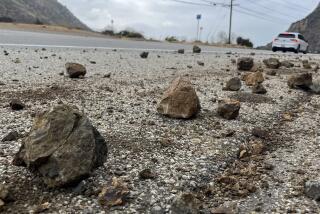THE LOS ANGELES EARTHQUAKE : DEALING WITH AN EARTHQUAKE ON THE ROAD
- Share via
The main dangers are collapsing bridges or overpasses, collapsed structures that become obstacles, flying tree limbs and fallen power lines. Flying glass is especially dangerous on surface streets. WHEN THE EARTHQUAKE STRIKES
Don’t panic because you feel you’re losing control. Avoid any abrupt maneuvering of your vehicle; don’t slam on the brakes or turn the steering wheel sharply in either direction.
Slow down.
Increase your distance from the vehicle in front of you.
If you are on an overpass and it’s safe to accelerate, get off as quickly as possible.
If it’s safe--if traffic is slow enough--pull over and stop when you reach an open area off the road.
When pulling over, make sure you’re not under high-tension power lines or overpasses. WHEN THE SHOCKS STOP
Proceed cautiously.
It’s safest to return home if you’re not near an open space. Roads should be kept as clear as possible for emergency vehicles.
Stay in the car if a power line comes down near you. If electrical wires have fallen across your vehicle, do not get out. The rubber tires will act as insulators, and you could become a conductor for the electricity if you get out of the car.
Expect aftershocks.
Listen to the radio for instructions from public safety agencies.
Sources: California Highway Patrol, the American Red Cross
More to Read
Sign up for Essential California
The most important California stories and recommendations in your inbox every morning.
You may occasionally receive promotional content from the Los Angeles Times.










